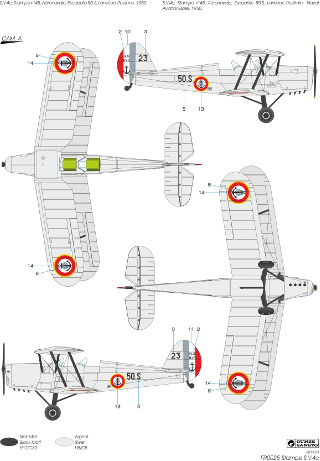FR0025 Stampe S.V.4c France - Sold out
History:
The Stampe et Vertongen S.V.4 is probably one of the Belgian aeronautical industry‘s most outstanding successes. Jean Stampe’s aim was to design a training plane with very good aerobatic capabilities, which as the SV4’s career proves, is something that he did very well.

The Stampe S.V.4b (“b” for bis or second version) was registered as OO-ATC. It won competitions held by the Belgian Aéronautique Militaire and the French Armée de l’Air, which were both held in the summer of 1939. The Belgians ordered thirty planes for their Aé. Mil. to be delivered between December 1939 and May 1940. Michel Donnet and Léon Divoy later “liberated” the prototype backup, registered as OO-ATD, on July 4th 1941, and used it to escape from occupied Belgium to England.
The French and Belgian air forces both lacked training aircraft following WWII. In 1947, Belgium ordered sixty-five of the S.V.4b version, although these differed slightly from the pre-war version, being fitted with a more powerful Gipsy Major X engine and having a removable sliding canopy. France initially ordered 701 SV4’s powered by a 4-POI Renault engine built under licence in Sartrouville, and then ordered 150 more units to be built in Algeria. The Renault powered version was designated Stampe S.V.4c.
The Armée de l’Air (French Air Force) used the S.V.4c for elementary training and liaison. The Patrouille d’Etampes, an aerobatic display team preceding the Patrouille de France, also used these planes from June 1947 until 1953. The Aéronavale (French Navy) also used S.V.4c from 1947 to 1968 in training schools; these being coded 50.S to 59.S. Forty more served with the Aviation Légère de l’Armée de Terre (French Army) and were based at Mainz, Nancy and Dax.
S.V.4’s are still in use nowadays, and owners and enthusiasts of this remarkably successful design are supported by the “Stampe Club”.
Specs: Single engined two-seat aerobatic capable trainer biplane. Wingspan: 8,39 m (upper wing) and 8 m (lower wing), length 6,97 m, wing area 8,06 m2, weight (empty) 529 kg, maximum weight 770 kg. With a Renault 4-PO3 engine, maximum speed at sea level 198 km/h.
Additional information, documentation:
- All boxes contain two common plastic sprues, including two cowlings (Gipsy and Renault) and transparent parts for all versions (2 windshields for the open cockpit version, one closed canopy for the standard belgian version, and one for the Manchots aerobatic team) as well as a commmon resin sprue giving two Venturis, two humps for version a (allows to go from version c to version a, aerobatics) and one Pitot tube. A specific resin part is added, when needed.
- Documentation : Les avions Stampe, Réginald Jouhaud (Wimpel Amsterdam), and the Ouest France booklet, also from Reginald Jouhaud
Camouflage schemes:
- Aéronavale, aircraft 23 in escadrille 50.S (S.V.4c n°45), please have a look at the boxart, above
- ALAT, S.V.4c n°360 code L-Q, overall green
- F-BDEE, S.V.4c n°586 of SFA (Service de la Formation Aéronautique) overall aluminium with orange dayglo panels


